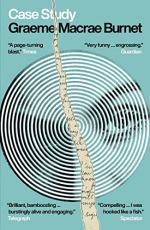|
This section contains 818 words (approx. 3 pages at 400 words per page) |

|
Case Study: A Novel Summary & Study Guide Description
Case Study: A Novel Summary & Study Guide includes comprehensive information and analysis to help you understand the book. This study guide contains the following sections:
This detailed literature summary also contains Quotes and a Free Quiz on Case Study: A Novel by Graeme MaCrae Burnet.
The following version of this book was used to create the guide: Burnet, Graeme Macrae. Case Study. Saraband, 2022.
Graeme Macrae Burnet's novel Case Study is written from the first and third person points of view and employs an unconventional, meta-narrative structure. The auto-fictional author GMB presents a series of notebooks written by an unnamed first person narrator. These notebooks appear interspersed on the page with sections from GMB's biographical writings about the controversial psychotherapist Dr. Collins Braithwaite. GMB begins their text with a preface, describing their introduction to the notebooks, and ends with a postscript, detailing their first encounter with the notebook's author. The following summary relies upon the past tense and a more streamlined narrative structure.
While GMB was working on their biography of Braithwaite's life and career, they received an email from a person named Martin Grey. Grey had discovered a series of notebooks allegedly written by his cousin in his uncle's attic. Understanding that GMB was writing about Braithwaite, Grey thought the notebooks, which heavily featured Braithwaite, might be of interest to GMB. Although Grey refused to meet with GMB and GMB struggled to authenticate the notebooks' provenance, they decided to include them in their biographical text.
The narrator decided to devote her notebooks to a new project she had recently designed. Following her sister Veronica's suicide, she became interested in Veronica's former psychotherapist, Braithwaite. She read his works and became convinced his controversial ideas led Veronica to kill herself. Determined to prove Braithwaite's culpability, the narrator planned to pose as one of Braithwaite's new patients, a character she had designed named Rebecca Smyth. She would detail Rebecca's sessions with and impressions of Braithwaite in her books.
Before her first session with Braithwaite, the narrator carefully crafted her Rebecca persona. She believed Rebecca would have to appear and act slightly unhinged, but not entirely slovenly. While waiting for her appointment, she encountered a young man named Tom on the street, on whom she tried out her new Rebecca identity.
Over the course of her sessions with Braithwaite, the narrator became increasingly enthralled by her new identity. She loved playing the part of Rebecca. At first, Rebecca was a mask of her creation. Over time, Rebecca became increasingly autonomous. On a date with Tom one afternoon, the narrator marveled at how bold and unabashed Rebecca was. She was unafraid of flirting or speaking her mind.
Although the narrator was always inhabiting Rebecca while meeting with Braithwaite, she feared he could see through her disguise. The more stories, anecdotes, and memories she shared with him, the more Braithwaite discerned about her true nature. She became increasingly confused as to who she actually was.
After a particularly trying session with Braithwaite, the narrator found the courage to go out with Tom by becoming Rebecca. When she and Tom finally kissed, however, the narrator burst out with the truth. She insisted Rebecca was fake and that she wanted him to see and kiss the real her. Unnerved, Tom scurried out of the bar.
In the weeks following, the narrator fell into a depression. Realizing that Rebecca would not survive if she died, she decided to discard her old self and to become Rebecca permanently.
In GMB's biographical writings, he details Braithwaite's early life, academic career, growing interest in philosophy and psychology, and rise to cultural prominence. After his father's suicide and his mother's death, Braithwaite distanced himself from his family, his home, and his former life. As a student at Oxford, he freed himself to the cultural changes abounding around him. He was not only delighted by his academic pursuits, but empowered by his sexual escapades.
After completing his thesis and graduating, Braithwaite lived an aimless life until he decided to write a book. The book, Kill Your Self, won Braithwaite increasing amounts of attention. His early followers were almost all actors. This was the start of Braithwaite's career as a psychotherapist.
After an actor named Richard Aaron discovered his wife Susanne Kepler had had sex with Braithwaite, he became convinced Braithwaite had raped her. He rushed to Braithwaite's, and attacked the doctor, who was engaged in sexually illicit behavior with two other young women. Braithwaite was later brought to trial, found guilty, and sentenced to a brief stint in prison. He lost his practice and was eventually forced to move back to his family's abandoned estate. He devoted the latter years of his life to writing his memoir, My Self and Other Strangers. He ultimately hanged himself in the family home, indicating the memoir as his suicide note.
Following the publication of their book, GMB received numerous letters insisting that the notebooks included in their text were dubious. In a final attempt to prove their provenance, GMB arranged a meeting with Grey. He soon learned that Grey was in fact another persona the narrator had donned in order to win GMB's trust and help.
Read more from the Study Guide
|
This section contains 818 words (approx. 3 pages at 400 words per page) |

|



